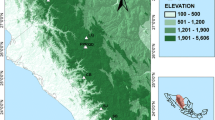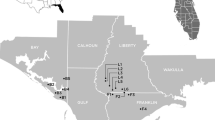Abstract
Genetic erosion can be defined as a permanent reduction in richness or evenness of common local alleles or the loss of combination of alleles over time in a defined area. This process can be detrimental to the short-term viability of individuals and populations, the evolutionary potential of populations and species, and the direct use of genetic resources. Various international and intergovernmental organizations and networks have therefore recognized the need to assess and monitor plant genetic erosion in order to prevent such effects. The rare tree species Picea chihuahuana Martínez, which is endemic to Mexico, is an excellent model for estimating potential genetic erosion. The species occurs in about 40 often isolated relict populations in the Sierra Madre Occidental. In this study, the degree of genetic erosion was evaluated in five populations of P. chihuahuana M. in the State of Durango (Mexico), by comparing the genetic diversity in diameter classes (as a surrogate variable for age classes). The results of the study demonstrate a moderate loss of genetic diversity at some amplified fragment length polymorphism (AFLP) loci from the older trees to saplings and to young seedlings in the two largest populations. Significant genetic erosion was only detected in a very small population, named San José de las Causas (SJ). Hence, if genetic diversity at AFLP loci reflects diversity in the genome on the whole, genetic erosion per se does not explain the relict status of Chihuahua spruce, except in very small populations, such as SJ, which comprised of ca. 120 individuals.




Similar content being viewed by others
References
Brown A, Young A, Burdon J, Christides L, Clarke G, Coates D, Sherwin W (1997) Genetic indicators for state of the environment reporting. State of the Environment Technical Paper Series (Environmental Indicators). Department of Environment Sport and Territories, Canberra, ACT
Bücking W (2003) Are there threshold numbers for protected forests? J Environ Manage 67:37–45
Diulgheroff S (2006) A global overview of assessing and monitoring genetic erosion of crop wild relatives and local varieties using WIEWS and other elements of the FAO Global System on PGR. In: Ford-Lloyd BV, Dias SR, Bettencourt E (eds) Genetic erosion and pollution assessment methodologies. Proceedings of PGR Forum Workshop 5, Terceira Island, Autonomous Region of the Azores, Portugal, 8–11 September 2004, pp. 35–45. Published on behalf of the European Crop Wild Relative Diversity Assessment and Conservation Forum, by Bioversity International, Rome, Italy, pp. 100, Available at http://www.bioversityinternational.org/fileadmin/bioversity/publications/pdfs/1171.pdf. Accessed 11 Jan 2010
FAO/IPGRI (2002) Review and development of indicators for genetic diversity, genetic erosion and genetic vulnerability (GDEV): summary report of a joint FAO/IPGRI workshop (Rome, 11–14 September, 2002)
Farjon A (2001) World checklist and bibliography of conifers, 2nd edn. Royal Botanical Gardens, Kew
Frankham R (1996) Relationship of genetic variation to population size in wildlife. Cons Biol 10(6):1500–1508
Frankham R, Ballou JD, Briscoe DA (2002) Introduction to conservation genetics. Cambridge University Press, Cambridge
Franklin JR (1980) Evolutionary change in small populations. In: Soule ME, Wilcox BA (eds) Conservation biology: an evolutionary-ecological perspective. Sinauer, Sunderland, pp 135–150
Gordon AG (1968) Ecology of Picea chihuahuana Martínez. Ecology 49:880–896
Gregorius HR (1978) The concept of genetic diversity and its formal relationship to heterozygosity and genetic distance. Math Biosci 41:253–271
Gregorius HR (1987) The relationship between the concepts of genetic diversity and differentiation. TAG 74:397–401
Gregorius HR, Degen B, König A (2007) Problems in the analysis of genetic differentiation among populations—a case study in Quercus robur. Silvae Genet 56:190–199
Jaramillo-Correa JP, Beaulieu J, Ledig FT, Bousquet J (2006) Decoupled mitochondrial and chloroplast DNA population structure reveals Holocene collapse and population isolation in a threatened Mexican-endemic conifer. Mol Ecol 15:2787–2800
Jump AS, Hunt JM, Peñuelas J (2006) Rapid climate change-related growth decline at the southern range edge of Fagus sylvatica. Mol Ecol 12(11):2163–2174
Kelly CK, Chase M, Fay MF, de Bruijn A, Woodward FI (2003) Temperature-based population segregation in birch. Ecol Lett 6:87–89
Ledig FT (1986) Heterozygosity, heterosis and fitness in outbreeding plants. In: Soulé ME (ed) Conservation biology, the science of scarcity and diversità. Sinauer Associates, Sunderland, pp 77–104
Ledig FT, Jacob-Cervantes V, Hodgskiss PD, Eguiluz-Piedra T (1997) Recent evolution and divergence among populations of a rare Mexican endemic, Chihuahua spruce, following Holocene climatic warming. Evolution 51(6):1815–1827
Ledig FT, Mápula-Larreta M, Bermejo-Velázquez B et al (2000) Locations of endangered spruce populations in México and the demography of Picea chihuahuana. Madrono 47:71–88
Ledig FT, Hodgskiss PD, Krutovskii KV, Neale DB, Eguiluz-Piedra T (2004) Relationships among the spruces (Picea, Pinaceae) of southwestern North America. Syst Bot 39:275–295
Ledig FT, Rehfeldt GE, Sáenz-Romero C, Flores-López C (2010) Projections of suitable habitat for rare species under global warming scenarios. Am J Bot 97(6):970–987
Lee CT, Wickneswari R, Mahani MC, Zakri AH (2002) Effect of selective logging on the genetic diversity of Scaphium macropodum. Biol Cons 104(1):107–118
Mahlman JD (1997) Uncertainties in projections of human-caused climate warming. Science 278:1416–1417
Maxted N, Guarino L (2006) Genetic erosion and genetic pollution of crop wild relatives. In: Ford-Lloyd BV, Dias SR, Bettencourt E (eds) Genetic erosion and pollution assessment methodologies. Proceedings of PGR Forum Workshop 5, Terceira Island, Autonomous Region of the Azores, Portugal, 8–11 September 2004, pp. 35–45. Published on behalf of the European Crop Wild Relative Diversity Assessment and Conservation Forum, by Bioversity International, Rome, Italy, pp. 100. Available at http://www.bioversityinternational.org/fileadmin/bioversity/publications/pdfs/1171.pdf. Accessed 11 Jan 2010
Millar CI, Libby WJ (1991) Strategies for conserving clinal, ecotypic, and disjunct population diversity in widespread species. In: Falk DA, Holsinger KE (eds) Genetics and conservation of rare plants. Oxford University Press, New York, pp 149–170
Narvaéz-Flores R (1984) Contribucion al conocimiento de la ecología de Picea chihuahuana Martínez. Unpublished thesis. Universidad Autónoma de Nuevo León, Monterrey, Nuevo León.
Nord-Larsen T, Cao QV (2006) A diameter distribution model for even-aged beech in Denmark Forest. Forest Ecol Manag 231(1–3):218–225
Schönswetter P, Tribsch A (2005) Vicariance and dispersal in the alpine perennial Bupleurum stellatum L. (Apiaceae). Taxon 54:725–732
Seymour RS, Kenefic LS (1998) Balance and sustainability in multi-aged stands: a northern conifer case study. J Forest 96:12–17
Simpson EH (1949) Measurement of diversity. Nature 163:688
Traill LW, Bradshaw JA, Brook BW (2007) Minimum viable population size: a meta-analysis of 30 years of published estimates. Biol Cons 139(1–2):159–166
Vos P, Hogers R, Bleeker M et al (1995) AFLP: a new concept for DNA fingerprinting. Nucleic Acids Res 23:4407–4414
Wehenkel C, Corral-Rivas JJ, Hernández-Díaz JC, Gadow Kv (2011) Estimating balanced structure areas in multi-species forests on the Sierra Madre Occidental, Mexico. Ann For Sci 68:385–394
Wehenkel C, Martínez-Guerrero JH, Pinedo-Alvarez A, Carrillo A (2012) Adaptive genetic differentiation in Picea chihuahuana M. caused by different copper concentrations in the top soil. Forstarchiv 83:48–51
Weir BS, Anderson AD, Hepler AB (2006) Genetic relatedness analysis: modern data and new challenges. Nat Rev Genet 7:771–780
Wright S (1938) Size of population and breeding structure in relation to evolution. Science 87:430–431
Acknowledgments
This study was supported by a grant from the Secretaría de Recursos Naturales y Medio Ambiente del Gobierno de Estado de Durango, México, the Universidad Juárez del Estado de Durango, México, and the Compañía Minera Mexicana Ciénega de Nuestra Señora, Santiago Papasquiaro, Durango, México.
Author information
Authors and Affiliations
Corresponding author
Additional information
Communicated by J. Beaulieu
Rights and permissions
About this article
Cite this article
Wehenkel, C., Sáenz-Romero, C. Estimating genetic erosion using the example of Picea chihuahuana Martínez. Tree Genetics & Genomes 8, 1085–1094 (2012). https://doi.org/10.1007/s11295-012-0488-5
Received:
Revised:
Accepted:
Published:
Issue Date:
DOI: https://doi.org/10.1007/s11295-012-0488-5




